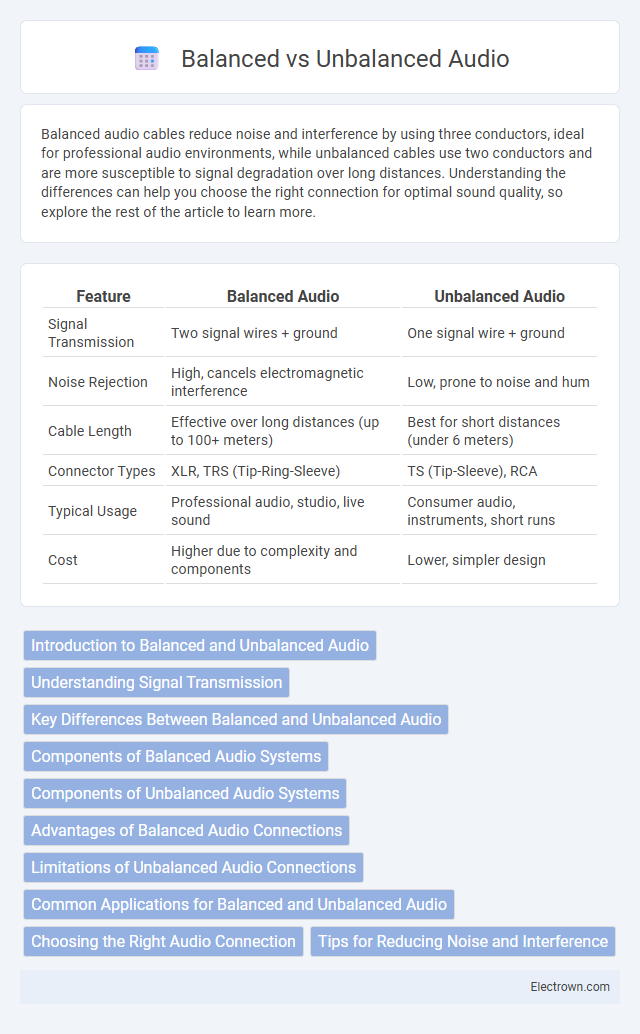Balanced audio cables reduce noise and interference by using three conductors, ideal for professional audio environments, while unbalanced cables use two conductors and are more susceptible to signal degradation over long distances. Understanding the differences can help you choose the right connection for optimal sound quality, so explore the rest of the article to learn more.
Table of Comparison
| Feature | Balanced Audio | Unbalanced Audio |
|---|---|---|
| Signal Transmission | Two signal wires + ground | One signal wire + ground |
| Noise Rejection | High, cancels electromagnetic interference | Low, prone to noise and hum |
| Cable Length | Effective over long distances (up to 100+ meters) | Best for short distances (under 6 meters) |
| Connector Types | XLR, TRS (Tip-Ring-Sleeve) | TS (Tip-Sleeve), RCA |
| Typical Usage | Professional audio, studio, live sound | Consumer audio, instruments, short runs |
| Cost | Higher due to complexity and components | Lower, simpler design |
Introduction to Balanced and Unbalanced Audio
Balanced audio uses three conductors--positive, negative, and ground--to reduce noise and interference over long cable runs, making it ideal for professional audio environments. Unbalanced audio employs two conductors--signal and ground--resulting in increased susceptibility to electromagnetic interference, suitable primarily for short cable distances. Understanding these differences is crucial for selecting the right audio connection to preserve signal integrity and minimize noise in various setups.
Understanding Signal Transmission
Balanced audio uses three conductors--positive, negative, and ground--to transmit signals, effectively canceling out noise and interference over long cable runs. Unbalanced audio employs two conductors--signal and ground--making it more susceptible to electromagnetic interference, especially in longer distances. Understanding this difference helps you choose the right cable type for clear, noise-free signal transmission in your audio setup.
Key Differences Between Balanced and Unbalanced Audio
Balanced audio uses three conductors--positive, negative, and ground--to reduce noise and electromagnetic interference, making it ideal for professional audio environments and long cable runs. Unbalanced audio relies on two conductors--signal and ground--which increases susceptibility to noise, suitable for short distances and consumer-grade equipment. The key difference lies in noise rejection capabilities, with balanced audio providing superior sound quality in challenging environments.
Components of Balanced Audio Systems
Balanced audio systems consist of three main components: two signal wires carrying the audio signal in opposite polarity and a ground wire to reduce noise interference. This design allows your equipment to cancel out electromagnetic interference, delivering a cleaner, clearer sound compared to unbalanced systems that rely on a single signal wire and ground. Using balanced audio cables and connectors like XLR or TRS ensures optimal signal integrity, especially over long cable runs.
Components of Unbalanced Audio Systems
Unbalanced audio systems consist of two conductors: a signal wire and a ground wire, which carry the audio signal and reference, respectively. Common connectors include RCA and TS (tip-sleeve) plugs, which are prone to noise and interference due to the lack of noise rejection. These systems are typically used in short cable runs and consumer audio equipment where cost and simplicity are prioritized over noise reduction.
Advantages of Balanced Audio Connections
Balanced audio connections provide superior noise rejection by using differential signaling, which cancels out electromagnetic interference and hum, ensuring a cleaner audio signal. They are ideal for long cable runs in professional audio environments, maintaining signal integrity over distances exceeding 100 feet without significant degradation. The three-conductor design--positive, negative, and ground--offers enhanced durability and reliability compared to unbalanced connections, making balanced audio the preferred choice for mixers, audio interfaces, and studio equipment.
Limitations of Unbalanced Audio Connections
Unbalanced audio connections are prone to electromagnetic interference and signal degradation over longer cable runs due to their single-conductor design with a ground shield. These limitations result in increased noise and reduced audio fidelity, especially in professional or high-demand environments. Your audio setup benefits from balanced connections when clear, interference-free signal transmission is crucial.
Common Applications for Balanced and Unbalanced Audio
Balanced audio cables are commonly used in professional settings such as recording studios, live sound environments, and broadcast applications due to their ability to reduce noise and interference over long cable runs. Unbalanced audio cables are frequently found in consumer electronics, such as home audio systems, musical instruments like electric guitars, and shorter cable connections where noise interference is less of a concern. Your choice between balanced and unbalanced audio should depend on the application, cable length, and environment where the audio signal is transmitted.
Choosing the Right Audio Connection
Choosing the right audio connection depends on factors such as signal quality, cable length, and interference levels. Balanced audio uses three conductors and differential signaling to minimize noise, making it ideal for long cable runs and professional environments. Unbalanced audio, with its simpler two-conductor design, suits short cable runs and less interference-prone setups like home audio systems.
Tips for Reducing Noise and Interference
Use balanced audio cables with three conductors--positive, negative, and ground--to minimize electromagnetic interference and noise in professional audio setups. Keep unbalanced cables short and away from power lines or devices emitting radio frequency interference to reduce hum and buzz. Employ proper grounding techniques and quality connectors to ensure signal integrity and maintain low-noise audio transmission.
Balanced vs Unbalanced Audio Infographic

 electrown.com
electrown.com